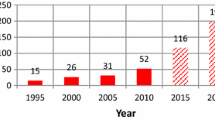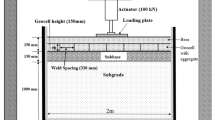Abstract
Pavement engineers are constantly trying to develop correlations between functional and structural indicators to develop best practices for pavement evaluation and make more informative maintenance and repair (M&R) decisions. This study aims to thoroughly investigate the interaction between the International Roughness Index (IRI), a standard index used to quantify the functional properties of a pavement, and various deflection-based parameters (DBPs) used to detect changes in the structural integrity of pavement. To achieve this goal, long-term pavement performance (LTPP) data from two different Pavements A and B are analyzed. The focus is to diagnose roughness problems detected on pavement surfaces by analyzing the predictability of DBPs based on IRI and pavement layer thickness. It is observed that two IRI values are at least needed to properly reflect the pavement profile condition; a median level and an upper level corresponding to the 90th percentile of a subsection’s IRI level. For Pavement A, the median IRI is considered a good predictor, with an R2 value of 0.71, of the Surface Curvature Index that reflects the condition of the asphalt layers, whereas for Pavement B, the upper IRI is considered a good predictor, with a lower R2 value of 0.65, of the deflection index that reflects the pavement’s substructure condition (i.e., the condition at higher depths). From a practical perspective, the interaction between roughness and individual DBPs can help engineers and practitioners better identify the potential origin depth of roughness problems and optimize pavement condition assessment strategy.











Similar content being viewed by others
References
Pérez-Acebo H, Bejan S, Gonzalo-Orden H (2018) Transition probability matrices for flexible pavement deterioration models with half-year cycle time. Int J Civ Eng 16:1045–1056. https://doi.org/10.1007/s40999-017-0254-z
Fakhri M, Dezfoulian RS (2019) Pavement structural evaluation based on roughness and surface distress survey using neural network model. Constr Build Mater 204:768–780. https://doi.org/10.1016/j.conbuildmat.2019.01.142
Mubaraki M (2016) Highway subsurface assessment using pavement surface distress and roughness data. Int J Pavement Res Technol 9:393–402. https://doi.org/10.1016/j.ijprt.2016.10.001
Abdelaziz N, Abd El-Hakim RT, El-Badawy SM, Afify HA (2020) International Roughness Index prediction model for flexible pavements. Int J Pavement Eng 21:88–99. https://doi.org/10.1080/10298436.2018.1441414
Kim RE, Kang S, Spencer BF, Al-Qadi IL, Ozer H (2019) Impact on pavement roughness and deflection on fuel consumption using energy dissipation. J Eng Mech 145:04019080. https://doi.org/10.1061/(ASCE)EM.1943-7889.0001653
Gkyrtis K, Loizos A, Plati C (2021) Integrating pavement sensing data for pavement condition evaluation. Sensors 21:3104. https://doi.org/10.3390/s21093104
Al-Masaeid HR, Hani ZFB (2023) Effect of pavement roughness on arterial noise using different vehicle types. Int J Pavement Res Technol. https://doi.org/10.1007/s42947-023-00324-9
Fares A, Zayed T (2023) Industry- and academic-based trends in pavement roughness inspection technologies over the past five decades: a critical review. Remote Sens 15:2941. https://doi.org/10.3390/rs15112941
Grygierek M, Sternik KJ (2021) Identification of pavement model parameters in the area of discontinuous surface deformation based on FWD tests. Int J Civ Eng 19:265–282. https://doi.org/10.1007/s40999-020-00563-y
Saleh M (2016) Simplified approach for structural capacity evaluation of flexible pavements at the network level. Int J Pavement Eng 17:440–448. https://doi.org/10.1080/10298436.2014.993202
Hoffman MS (2003) Direct method for evaluating structural needs of flexible pavements with falling-weight deflectometer deflections. Transp Res Rec 1860:41–47. https://doi.org/10.3141/1860-05
Sollazo G, Fwa TF, Bosurgi G (2017) An ANN model to correlate roughness and structural performance in asphalt pavements. Constr Build Mater 134:684–693. https://doi.org/10.1016/j.conbuildmat.2016.12.186
Karballaeezadeh N, Mohammadzadeh DS, Moazemi D, Band SS, Mosavi A, Reuter U (2020) Smart structural health monitoring of flexible pavements using machine learning methods. Coatings 10:1100. https://doi.org/10.3390/coatings10111100
Al-Mansour AI, Shokri AA (2022) Correlation of pavement distress and roughness measurement. Appl Sci 12:3748. https://doi.org/10.3390/app12083748
Wu Z, Zhang Z, Abadie C (2013) Determining structural strength of existing asphalt layer using condition survey data. Int J Pavement Eng 14:603–611. https://doi.org/10.1080/10298436.2012.677845
Kirbaş U (2018) IRI sensitivity to the influence of surface distress on flexible pavements. Coatings 8:271. https://doi.org/10.3390/coatings8080271
Sholevar N, Golroo A, Esfahani SR (2022) Machine learning techniques for pavement condition evaluation. Autom Constr 136:104190. https://doi.org/10.1016/j.autcon.2022.104190
Cano-Ortiz S, Pascual-Muñoz P, Castro-Fresno D (2022) Machine learning algorithms for monitoring pavement performance. Autom Constr 139:104309. https://doi.org/10.1016/j.autcon.2022.104309
Haridas A, Peraka NSP, Biligiri KP (2022) Structural behavior prediction model for asphalt pavements: a deep neural network approach. J Test Eval 51:1021–1051
Chen X, Dong Q, Dong S (2022) Evaluation and prediction of pavement deflection parameters based on machine learning methods. Buildings 12:1928. https://doi.org/10.3390/buildings12111928
Bayat R, Talatahari S, Gandomi AH, Habibi M, Aminnejad B (2023) Artificial neural networks for flexible pavement. Information 14:62. https://doi.org/10.3390/info14020062
Xin J, Akiyama M, Frangopol DM (2023) Sustainability-informed management optimization of asphalt pavement considering risk evaluated by multiple performance indicators using deep neural networks. Reliab Eng Syst Saf 238:109448. https://doi.org/10.1016/j.ress.2023.109448
Gkyrtis K, Plati C, Loizos A (2022) Mechanistic analysis of asphalt pavements in support of pavement preservation decision-making. Infrastructures 7:61. https://doi.org/10.3390/infrastructures7050061
Hosseini SA, Smadi O (2022) How prediction accuracy can affect the decision-making process in pavement management system. Infrastructures 6:28. https://doi.org/10.3390/infrastructures6020028
Shohel Reza Amin M (2014) The pavement performance modeling: deterministic vs. stochastic approaches. In: Kadry S, El-Hami A (eds) Numerical methods for reliability and safety assessment. Springer, London, pp 179–196
Justo-Silva R, Ferreira A, Flintsch G (2021) Review on machine learning techniques for developing pavement performance prediction models. Sustainability 13:5248. https://doi.org/10.3390/su13095248
Horak E (2007) Surface moduli determined with the falling weight deflectometer used as benchmarking tool. In: Proceedings of the 26th Southern African transport conference: the challenges of implementing policy (SATC), July 9–12, 2007, Pretoria, South Africa, pp 284–293
Hakim B, Brown SF (2006) Pavement analysis using the FWD: practical difficulties and proposed simplification. In: Proceedings of the 10th international conference on asphalt pavement, August 12–17, 2006, Quebec, Canada, vol 3, pp 59–68
Losa M, Bacci R, Leandri P (2008) A statistical model for prediction of critical strains in pavements from deflection measurements. Road Mater Pavement Des 9:373–396. https://doi.org/10.1080/14680629.2008.9690175
Gkyrtis K, Armeni A, Loizos A (2022) A mechanistic perspective for airfield pavements evaluation focusing on the asphalt layers’ behaviour. Int J Pavement Eng 23:5087–5100. https://doi.org/10.1080/10298436.2021.1995733
Guo S, Liu G, Zhuang B, Fan Y, Zheng Z (2021) Influence of freeze-thaw cycles on mechanical response of levee pavement. Adv Civ Eng 2021:6639303. https://doi.org/10.1155/2021/6639303
Maser KR (1996) Condition assessment of transportation infrastructure using ground penetrating radar. J Infrastruct Syst 2:94–101. https://doi.org/10.1061/(ASCE)1076-0342(1996)2:2(94)
Abaza KA (2023) Stochastic-based pavement rehabilitation model at the network level with prediction uncertainty considerations. Road Mater Pavement Des. https://doi.org/10.1080/14680629.2022.2164330
Yang X, You Z, Hiller J, Watkins D (2017) Correlation analysis between temperature indices and flexible pavement distress predictions using mechanistic-empirical design. J Cold Reg Eng 31:04017009. https://doi.org/10.1061/(ASCE)CR.1943-5495.0000135
Gao Q, Fan L, Wei S, Li Y, Du Y, Liu C (2023) Differences evaluation of pavement roughness distribution based on light detection and ranging data. Appl Sci 13:8080. https://doi.org/10.3390/app13148080
Chandra S, Ravi Sekhar C, Kumar Bharti A, Kangadurai B (2013) Relationship between pavement roughness and distress parameters for Indian highways. J Transp Eng 139:467–475. https://doi.org/10.1061/(ASCE)TE.1943-5436.0000512
Kakara S, Chowdary V (2020) Effect of pavement roughness and transverse slope on the magnitude of wheel loads. Arab J Sci Eng 45:4405–4418. https://doi.org/10.1007/s13369-020-04492-9
Elnashar G, Bhat RB, Sedaghati R (2019) Modeling and dynamic analysis of a vehicle-flexible pavement coupled system subjected to road surface excitation. J Mech Sci Technol 33:3115–3125. https://doi.org/10.1007/s12206-019-0606-5
Bilodeau JP, Gagnon L, Doré G (2017) Assessment of the relationship between the international roughness index and dynamic loading of heavy vehicles. Int J Pavement Eng 18:693–701. https://doi.org/10.1080/10298436.2015.1121780
Author information
Authors and Affiliations
Contributions
Conceptualization: CP, KG, AL; methodology: CP, KG, AL; formal analysis and investigation: KG; writing—original draft preparation: KG; writing—review and editing: CP, KG, AL.
Corresponding author
Ethics declarations
Conflict of interest
The authors declare that they have no conflicts of interest.
Rights and permissions
Springer Nature or its licensor (e.g. a society or other partner) holds exclusive rights to this article under a publishing agreement with the author(s) or other rightsholder(s); author self-archiving of the accepted manuscript version of this article is solely governed by the terms of such publishing agreement and applicable law.
About this article
Cite this article
Plati, C., Gkyrtis, K. & Loizos, A. A Practice-Based Approach to Diagnose Pavement Roughness Problems. Int J Civ Eng 22, 453–465 (2024). https://doi.org/10.1007/s40999-023-00900-x
Received:
Revised:
Accepted:
Published:
Issue Date:
DOI: https://doi.org/10.1007/s40999-023-00900-x




